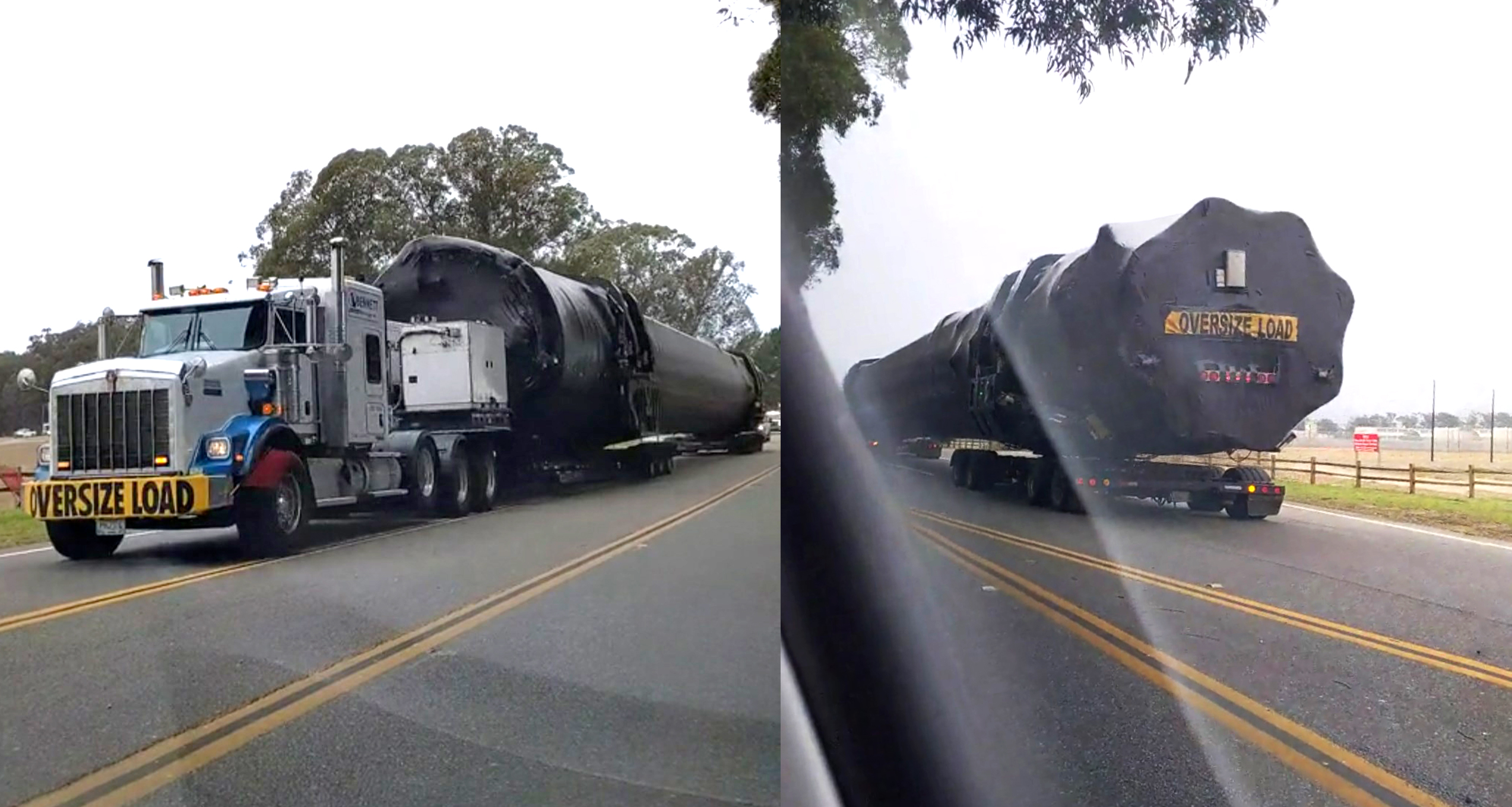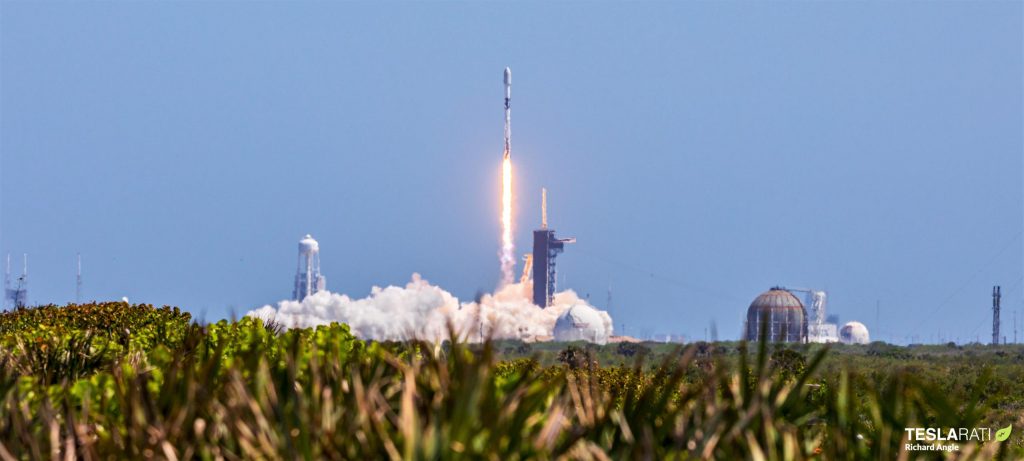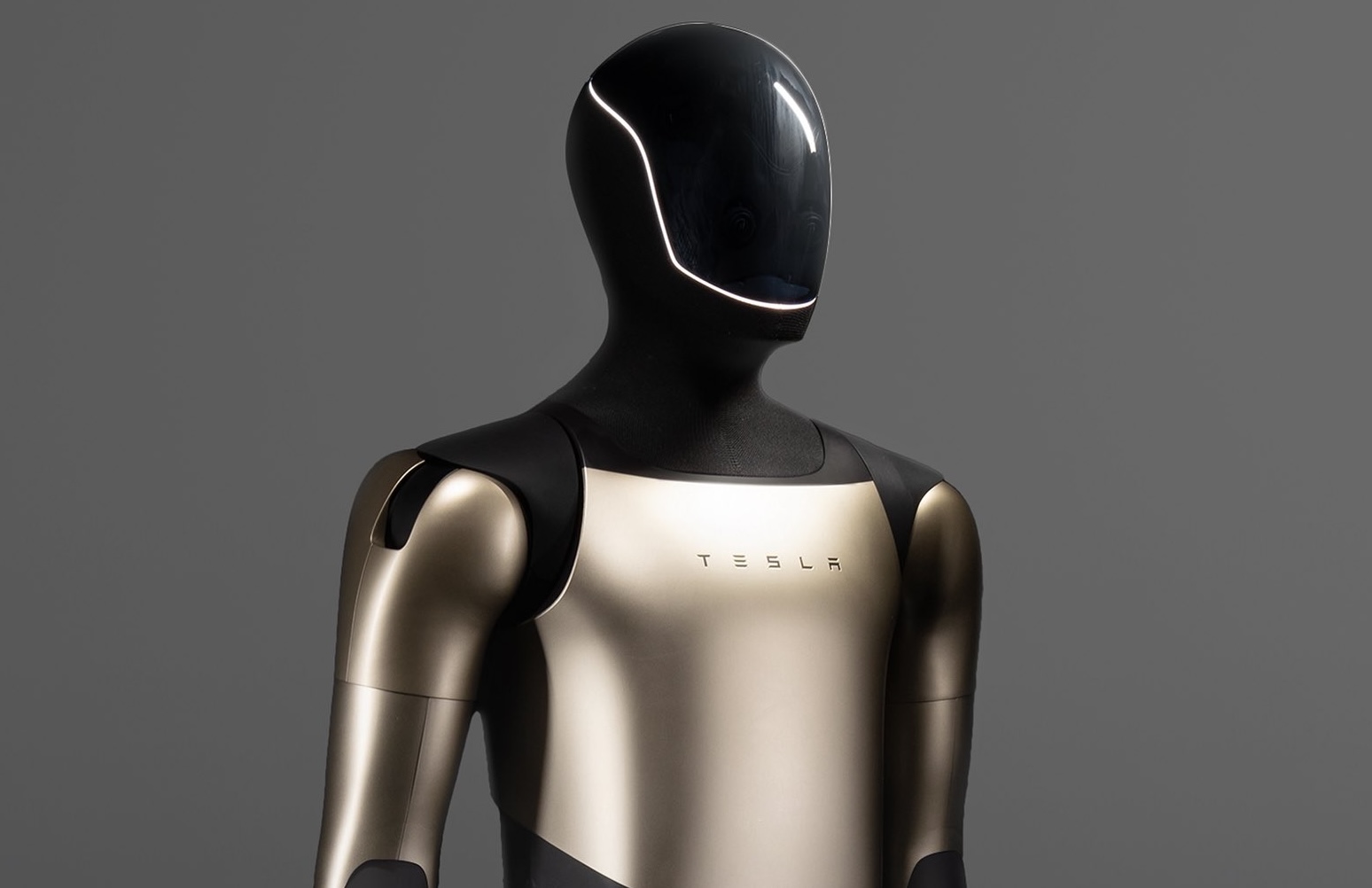

News
SpaceX sends reused Falcon 9 booster west for first California Starlink launches
SpaceX has shipped the first of one or two flight-proven Falcon 9 boosters from Florida to California in the latest sign that the company is preparing to begin dedicated polar Starlink launches in the near future.
On May 27th, a Reddit post revealed a Falcon 9 booster arriving at Vandenberg Air/Space Force Base (VAFB), the home of SpaceX’s West Coast SLC-4E launch pad. Only truly useful for polar or high-inclination launches with satellites that need to orbit the Earth’s poles instead of the equator, SpaceX has only used SLC-4E twice in the last two years – once in June 2019 and most recently in November 2020.
Now, amidst a major hiring spree and rare new activity at a nearby Los Angeles port, SpaceX is clearly gearing up to return its SLC-4E launch pad to active duty.
B1049 began its career in Florida (Telstar 18V), moved to Vandenberg for its second flight (Iridium-8), went back to Florida for seven Starlink missions, and is once again returning to the best coast.— Michael Baylor (@nextspaceflight) May 27, 2021

Both recent West Coast Falcon 9 missions hosted booster landings at LZ-4, a landing zone situated a little over 1000 feet (300m) away from the launch pad. That freed up SpaceX to ship former West Coast drone ship Just Read The Instructions (JRT) across the Panama Canal in August 2019, where it ultimately joined the company’s Florida rocket recovery fleet in early 2020 to support a major launch cadence ramp.
As a partial result, SpaceX was able launch Falcon 9 26 times in 2020, beating the previous record – 21 flights – by almost a quarter. In 2021, SpaceX is well on its way to smashing that annual launch record again and has completed 16 orbital launches with seven full months left in the year. That cadence is pushing SpaceX’s launch pads, recovery ships, and booster fleet to their limits. Due to the voracious demands of SpaceX’s almost weekly launch cadence, the company would only be shipping a workhorse booster to Vandenberg if there was a pressing need for it.
Said to be Falcon 9 B1049 by Next Spaceflight and NASASpaceflight reporter Michael Baylor, the booster that arrived at Vandenberg Air Force Base on Thursday has flown nine times – two of which it completed in February and May 2021. B1049 hasn’t been the most rapidly reusable of the fleet and is the oldest Falcon booster still operational after debuting in September 2018. However, SpaceX’s SLC-4E is relatively old itself and recruiting documents distributed as recently as 2021 indicated that the company’s West Coast resurgence was targeting a maximum cadence of one launch per month.
Virtually all of those missions will carry the company’s own Starlink satellites. On Wednesday, May 26th, SpaceX completed its 28th operational East Coast Starlink launch, effectively completing the first ‘tranche’ of the constellation once the satellites already in space reach their operational orbits. In April, SpaceX COO and President Gwynne Shotwell stated that polar Starlink launches would begin not long after that 28-launch milestones.
The day before B1049 arrived, SpaceX filed the first regulatory documents for at least six Vandenberg Starlink launches between July 2021 and January 2022 – one mission per month. It’s hard to say when the first launch will come. With B1049 now on site, FCC permits in work, and a new berth lease active in Port of Long Beach, the only real piece of the equation missing is a drone ship to support polar Starlink launches. According to said FCC documents, SpaceX will continue to push Falcon 9 to its limits on the West Coast, recovering boosters 640 km (~400 mi) downrange after polar Starlink launches.
SpaceX’s two operational drone ships – OCISLY and JRTI – currently have their hands full on the East Coast. Transporting either to California will take several weeks, limiting SpaceX’s East Coast launch cadence during that period. SpaceX and its contractors are currently hard at work completing a third drone ship – A Shortfall of Gravitas (ASOG), but past experience suggests that the vessel is at least a few months away from completion.
Once a drone ship has arrived at SpaceX’s new West Coast docks, though, the company will have almost everything it needs to kick off polar Starlink launches.
News
Tesla loses Model Y program manager in second blow in single day

Tesla has lost its Model Y Program Manager, he announced on LinkedIn, marking the second major departure from the company today.
Emmanuel Lamacchia has been in the role for 4 years and 7 months, responsible for the rollout of the all-electric crossover in several markets.
The Model Y became the best-selling vehicle in the world for two years under Lamacchia’s watch, making this a huge loss for the company. However, it seems the decision was made under Lamacchia’s own initiative.
He confirmed his decision on LinkedIn:
“After 8 incredible years, I’m moving on from Tesla.
What a journey it’s been… from leading NPI for Model 3 and Model Y variants to becoming the Vehicle Program Manager for Model Y, the best-selling car in the world!
Leading the All-New Model Y launch was the highlight: converting all 4 factories across 3 continents in just 2 weeks. Something that had never been done before in the auto industry.
To the teams who made this possible: you should be incredibly proud. This achievement belongs to you: the engineers, designers, buyers, and associates in Fremont, Shanghai, Berlin, and Austin who turned an impossible timeline into reality.
Grateful to the leaders who trusted me with programs that stretched my capabilities and to the cross-functional partners who showed me that great solutions come from collaboration, not hierarchy.
Tesla taught me how to move fast without breaking things and how to scale from prototypes to millions of units.
Excited for what’s next. More to share soon.”
It marks the second major program loss for Tesla today, as it also bid farewell to Cybertruck and Model 3 Program Manager Siddhant Awasthi, who said he left voluntarily in “one of the hardest decisions of his life.”
Lamacchia was at Tesla for just a shade under eight years, and previously worked for Rolls-Royce for roughly the same amount of time.
After the loss of both Lamacchia and Awasthi today, Tesla has lost a handful of key executives in 2025, including:
- David Imai, Director of Design
- David Lau, VP of Software Engineering
- Mark Westfall, Head of Mechanical Engineering
- Prashant Menon, Regional Director in India
- Vineet Mehta, Head of Battery Architecture
- Omead Afshar, VP/Head of Sales and Manufacturing in North America
- Milan Kovac, Head of Optimus Team
- Jenna Ferrua, Director of HR
- Troy Jones, VP of Sales, Service, and Delivery
- Pete Bannon, VP of Hardware Engineering
- Piero Landolfi, Director of Service
News
Tesla prepares to expand Giga Texas with new Optimus production plant
Drone operator Joe Tegtmeyer recognized Tesla construction crews performing ground leveling and clearing efforts at the plant earlier today.

Tesla is preparing to expand Gigafactory Texas once again with a brand new facility that will house the eventual manufacturing efforts for Optimus, its humanoid robot.
It is already building some units on a Pilot line at the Fremont Factory in Northern California, but Tesla is planning to build the vast majority of its Optimus project at Gigafactory Texas.
Tesla Optimus gets its latest job, and it’s not in the company’s factories
It will build one million units per year in Fremont, but CEO Elon Musk said the company would build 10 million units every year in Texas at a new building at Giga Texas.
Musk said:
“I think there could be tens of billions of Optimus robots out there. Um, now obviously it’s very important we pay close attention to safety here. Then a 10 million unit uh per year production line here the I don’t know where we’re going to put the 100 million unit production line. on Mars. Maybe on Mars, I don’t know.”
Evidently, Tesla is ready to begin thinking about the production efforts of Optimus beyond a theoretical standpoint and is starting to prepare for the construction of the manufacturing plant on Giga Texas property.
Drone operator Joe Tegtmeyer recognized Tesla construction crews performing ground leveling and clearing efforts at the plant earlier today:
Giga Texas News!
A brand-new, stand-alone factory is starting construction! This follows the Shareholders meeting & info that a 10-million-per-year @Tesla_Optimus production facility “on the Giga Texas campus” will be built & enter into production in 2027!
Here are some… pic.twitter.com/7ig5DohfOt
— Joe Tegtmeyer 🚀 🤠🛸😎 (@JoeTegtmeyer) November 10, 2025
Production is still slated for 2027, at least at Gigafactory Texas. As previously mentioned, the company is building some units in Fremont for the time being, at least until subsequent versions of the Optimus project advance.
Tesla has done a great job of advancing Optimus forward, but it also has truly grand expectations for the project.
Musk said it could potentially be the biggest product in the history of the planet, as it will revolutionize the way humans perform tasks, probably eliminating monotonous tasks from everyday life.
News
Tesla reveals its first Semi customer after launch

Tesla revealed its first customer for the all-electric Semi truck after it launches next year. Who it truly is should not be a surprise.
The Semi is going to finally start deliveries to new companies outside of Tesla’s pilot program starting in 2026. The company has been building a dedicated production facility in Reno, Nevada, that has finally taken shape, but Tesla was evidently not finished with the Semi’s development.
Last week at the Annual Shareholder Meeting, Tesla said it had implemented some new designs into the Semi, helping with efficiency, updating its design, and making it a more suitable vehicle for hauling loads, as the changes also helped increase payload.
Tesla has obtained a lengthy list of companies that have committed to implementing the Semi in their own fleets, hoping to bring their logistics lineups up to date with electric powertrains and autonomous technologies.
While it is already operating a pilot program with PepsiCo. and Frito-Lay, Tesla will expand to other businesses, primarily using it internally after its launch.
Head of the Semi program at Tesla, Dan Priestley, said the company would be the first user of the vehicle after its launch next year. It has been using it to a certain extent, but the company has not been able to completely abandon gas haulers.
Instead, it will implement the Semi into its fleet for more sustainable vehicle logistics starting next year:
Tesla will be the first customer as we electrify our supply chain. This includes Texas operations.
— Dan Priestley (@danWpriestley) November 7, 2025
Tesla has already received orders for the Semi from a variety of large companies, including Walmart, Sysco, Anheuser-Busch, UPS, DHL, J.B. Hunt, among others.
Many analysts see the Tesla Semi as a major contributor to future growth and increasing value within the company, especially from a Wall Street perspective. Some firms say the Semi is one of several near and medium-term contributors to the company increasing its market cap.
Cantor Fitzgerald is just one of those firms, as last week it explicitly listed the Semi as a catalyst.
Analyst Andres Sheppard said, “Overall, we remain bullish on TSLA over the medium to long term. We continue to see meaningful future upside from Energy Storage & Deployment, FSD, Robotaxis/Cybercab, Semis, and Optimus Bots.”
-

 News3 days ago
News3 days agoTesla shares rare peek at Semi factory’s interior
-

 Elon Musk3 days ago
Elon Musk3 days agoTesla says texting and driving capability is coming ‘in a month or two’
-

 News2 days ago
News2 days agoTesla makes online ordering even easier
-

 News2 days ago
News2 days agoTesla Model Y Performance set for new market entrance in Q1
-

 News3 days ago
News3 days agoTesla Cybercab production starts Q2 2026, Elon Musk confirms
-

 News3 days ago
News3 days agoTesla China expecting full FSD approval in Q1 2026: Elon Musk
-

 News4 days ago
News4 days agoTesla Model Y Performance is rapidly moving toward customer deliveries
-

 News1 day ago
News1 day agoTesla is launching a crazy new Rental program with cheap daily rates



















